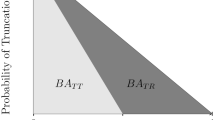Abstract
This paper studies welfare tradeoffs in two-sided, one-to-one matching markets. We begin by providing theoretical upper bounds on a utilitarian price of stability, and show that these bounds vary with the composition of participants’ ordinal preference lists. We then turn to simulation experiments to describe how changes in basic characteristics of agents’ preferences can increase or decrease the average price of stability as measured by both utilitarian and Rawlsian welfare criteria. Our results indicate that markets featuring moderate degrees of correlation and positive intercorrelation in the preferences of participants exhibit the steepest tradeoffs between stability and utilitarian welfare and between stability and Rawlsian welfare.
Similar content being viewed by others
References
Abdulkadiroglu A., Pathak P., Roth A. E., Sönmez T. (2005) The Boston public schools match. American Economic Review 95(2): 368–371
Abdulkadíroğlu A., Pathak P., Roth A. E. (2005) The New York city high school match. American Economic Review, Papers & Proceedings 95(2): 364–367
Abdulkadíroğlu, A., Pathak, P., Roth, A. E., & Sönmez, T. (2006). Changing the Boston school choice mechanism: Strategy-proofness as equal access. Working paper, MIT.
Balinski M., Sönmez T. (1999) A tale of two mechanisms: Student placement. Journal of Economic Theory 84: 73–94
Boudreau J. W. (2008) Preference structure and random paths to stability in matching markets. Economics Bulletin 3(67): 1–12
Boudreau J. W., Knoblauch V. (2010) Marriage matching and intercorrelation of preferences. Journal of Public Economic Theory 12(3): 587–602
Boudreau, J. W., & Knoblauch, V. (2011). What price stability? social welfare in matching markets. Working paper, UConn.
Caldarelli G., Cappoci A. (2001) Beauty and distance in the stable marriage problem. Physica A 300: 325–331
Celik, O. B., & Knoblauch, V. (2007). Marriage matching with correlated preferences. Working Paper 2007–16, University of Connecticut, Department of Economics.
Erdil A., Ergin H. (2008) What’s the matter with tie-breaking? improving efficiency in school choice. American Economic Review 98(3): 669–689
Gale D., Shapley L. S. (1962) College admissions and the stability of marriage. The American Mathematical Monthly 69(1): 9–15
Halaburda H. (2010) Unravelling in two-sided matching markets and similarity of preferences. Games and Economic Behavior 69(2): 365–393
Kesten O. (2010) School choice with consent. Quarterly Journal of Economics 125(3): 1297–1348
Klaus B., Klijn F. (2006) Median stable matching for college admissions. International Journal of Game Theory 34: 1–11
Klaus B., Klijn F. (2007) Fair and efficient student placement with couples. International Journal of Game Theory 36: 177–207
Klaus B., Klijn F. (2010) Smith and Rawls share a room: Stability and medians. Social Choice and Welfare 35: 647–667
Kuhn H. W. (1955) The Hungarian method for the assignment problem. Naval Research Logistics Quarterly 2(7): 83–97
Masarani F., Gokturk S. S. (1989) On the existence of fair matching algorithms. Theory and Decision 26: 305–322
Maskin E. (1978) A theorem on utilitarianism. Review of Economic Studies 45(1): 93–96
McVitie D. G., Wilson L. B. (1971) The stable marriage problem. Communications of the ACM 14(7): 486–490
Rawls J. (1971) A theory of justice. Harvard University Press, Cambridge, MA
Romero-Medina A. (2001) Sex-equal stable matchings. Theory and Decision 50: 197–212
Romero-Medina A. (2005) Equitable selection in bilateral matching markets. Theory and Decision 58: 305–324
Roth A. E. (1982) The economics of matching: Stability and incentives. Mathematics of Operations Research 7(4): 617–628
Roth A. E. (1984) The evolution of the labor market for medical interns and residents: A case study in game theory. The Journal of Political Economy 92(6): 991–1016
Roth A. E. (2008) Deferred acceptance algorithms: History, theory, practice and open questions. International Journal of Game Theory 36: 537–569
Roth A. E., Peranson E. (1999) The redesign of the matching market for american physicians: Some engineering aspects of economic design. American Economic Review 89(4): 748–780
Roth A. E., Sotomayor M. (1990) Two-sided matching: A study in game-theoretic modeling and analysis. Cambridge University Press, Cambridge, MA
Roth A. E., Xing X. (1994) Jumping the gun: Imperfections and institutions related to the timing of market transactions. American Economic Review 84(4): 992–1044
Roughgarden T., Nisan N. (2007) Introduction to the inefficiency of equilibria. In: Nisan N., Roughgarden T., Vazirani V. V., Vazirani V. V. (eds) Algorithmic game theory. Cambridge University Press, Cambridge, pp 443–459
Teo C.-P., Sethuraman J. (1998) The geometry of fractional stable matchings and its applications. Mathematics of Operations Research 23(4): 874–891
Teo C. P., Sethuraman J., Tan W. P. (2001) Gale–Shapley stable marriage problem revisited: Strategic issues and applications. Management Science 47(9): 1252–1267
Author information
Authors and Affiliations
Corresponding author
Rights and permissions
About this article
Cite this article
Boudreau, J.W., Knoblauch, V. Preferences and the price of stability in matching markets. Theory Decis 74, 565–589 (2013). https://doi.org/10.1007/s11238-012-9319-2
Published:
Issue Date:
DOI: https://doi.org/10.1007/s11238-012-9319-2




